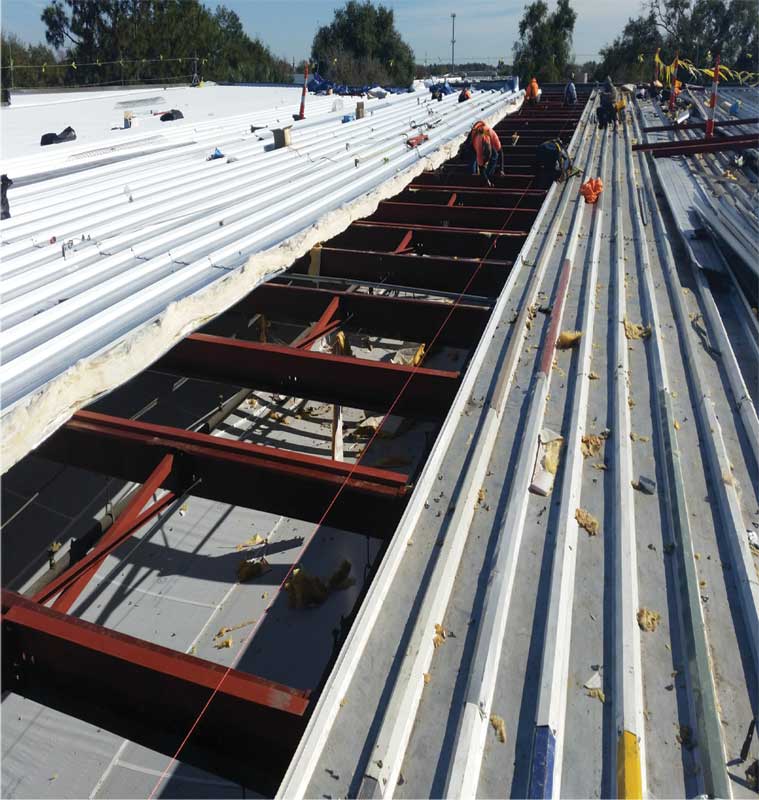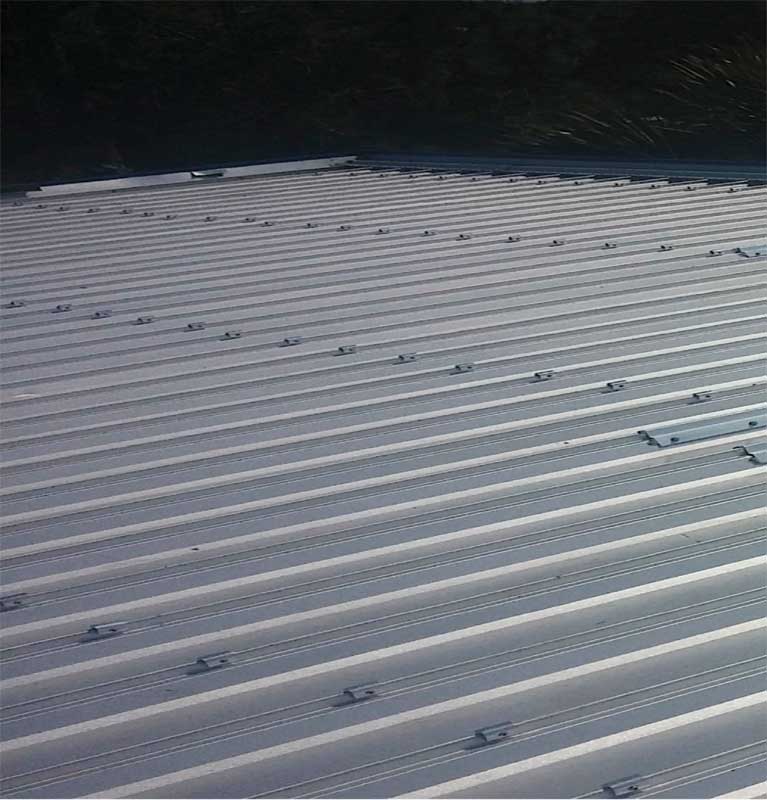External seam clamps
Shown in Figure 7, external seam clamps (i.e. wind clamps) are extruded pieces of aluminum placed on the panel seams to prevent male-to-female seam separation. When used at clip locations, these devices also prevent seam-to-clip disengagement.
Wind clamps significantly increase the uplift capacity of the roof panel system. Recent testing by independent laboratories and metal roof manufacturers have shown design load improvements of 50 percent, to as much as 300 percent, using the ASTM E1592 test protocol. With the low cost of these products compared to other mitigation options, metal roof manufacturers are finding the seam clamps to be value-driven solutions to meeting test pressures.
Factory Mutual began studying these clamps several years ago as a cost-effective method to increase design roof pressures for metal roof assemblies. Based on their successes, it began requiring FM-approved external seam clamps on standing-seam metal roofs in areas subject to cyclones and hurricanes, beginning mid-2016.
Specifying external seam clamps is a relatively simple addition to the standing-seam roof panel section. Adding one descriptive paragraph into the metal roof accessories subsection is all that is necessary to increase their overall performance and longevity.
Conclusion
Architectural standing-seam metal roofing can be a long-lasting and attractive solution that provide many years of protection against the elements, including severe tropical storms and hurricanes. Methods and products for designing these roofs to withstand significant wind events include increasing the gauge of the metal and decreasing the seam spacing and adding external seam clamps. This assists in mitigating the negative effects of wind uplift on these roof types, keeping them in place to protect the structure, along with its occupants and contents.
External seam clamps have shown to be a cost-effective method in providing significant wind uplift mitigation. As metal roof manufacturers continue to perform ASTM tests with this new option, they are finding instances when metal roofs could be considered where before they were unable to meet required pressures. They are also finding external seam clamps as a simple and cost-effective method to upgrade existing metal roofs.
To ensure the best options possible are being specified, one should include ASTM E1592 in the specification as the proper test regimen for standing-seam metal roofs. Adding external seam clamps into the Roof Accessories section can also be an important consideration for a project.
| CASE STUDY EXAMPLE |
  In 2013, the roof of Trulite Glass’ manufacturing facility in Orlando blew off when wind entered open doors during a micro-burst and caused positive internal pressure in the building. The roof is approximately 76 x 76 m (250 ft x 250 ft) and had a projected replacement cost of $1.4 million. Existing roof purlins were 1.5 m (5 ft) on center (o.c.), as shown in Photo A. To bring the roof up to current code standards, purlins would have to be added at 0.76 m (2 ½ ft) o.c., and the roof seams would have to be placed 305 mm The metal roof manufacturer offered an alternate solution to additional purlins/mounting clips and decreased seam spacing based on ASTM E1592, Standard Test Method for Structural Performance of Sheet Metal Roof and Siding Systems by Uniform Static Air Pressure Difference, testing of its product using external seam clamps. By adding these wind clamps, the design permitted purlin spacing to be maintained at 1.5-m centers. It also enabled panel seams to be decreased in the roof center—there was 305-mm spacing on edge zones and 610-mm (24-in.) spacing in the center zone. While these changes saved several thousand dollars in materials and labor, the big savings were felt by the operating facility itself. As there were no purlins added, there was no interior building work required. This allowed the factory to run unimpeded during the entire reroofing process, savings hundreds of thousands of dollars in manufacturing interruptions and shutdowns. All these savings were achieved for the cost of a few thousand dollars on wind clamps added to the project (Photo B). |
Harry J. Lubitz, CSI, CDT, is the architectural and national accounts manager for S-5! Metal Roof Innovations (Colorado Springs, Colorado). He works with the design community to develop and improve architectural specifications for metal roofs and attachment systems. Lubitz has more than 25 years of experience in the building materials industry, is active in numerous architectural and professional organizations including CSI, and has served as an adjunct faculty member at Lord Fairfax Community College in Virginia. He can be reached via e-mail at hlubitz@S-5.com




